#deoksugung palace
Explore tagged Tumblr posts
Text

Old and new.
8 notes
·
View notes
Text

Deoksugung Palace, Seoul, South Korea.
12 notes
·
View notes
Text
Into the Breach
On 25 June 1950, after the creation of two separate governments in Korea following the end of World War II, North Korea (also known as the Democratic Republic of Korea) launched an attack on its neighbour in order to subsume it. After fighting the South Koreans (Republic of Korea) down to Busan, the South Korean army rallied with the help of the United States. Their counteroffensive nearly pushed North Korean troops into China. With the aid of weapons and artillery bequeathed by the Soviets, China entered the Korean War. Following intense fighting, the front was stablised close to the 38th parallel with the final two years of the war becoming a war of attrition. An armistice was later signed in 1953.
The signing of the armistice paused hostilities on the Korean peninsula and created the Korean Demilitarised Zone, or DMZ (pronounced Dee-Em-Zed) for short.
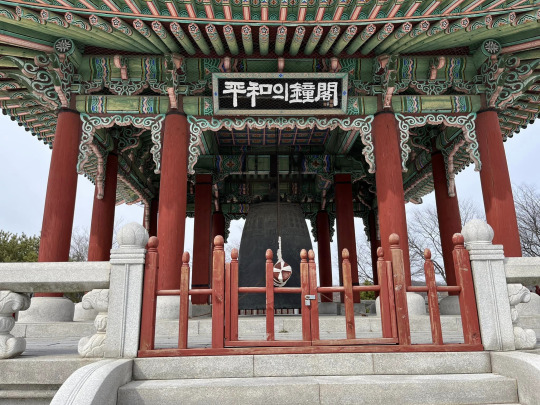
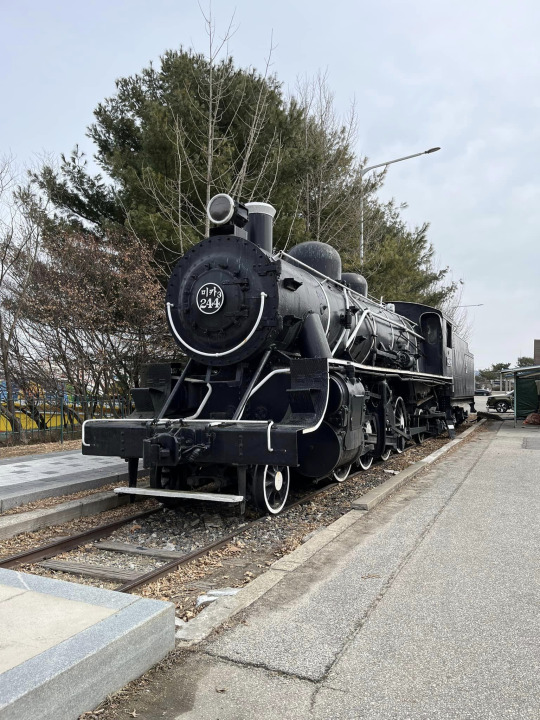
On our second proper day in Seoul, bleachpanda and I joined a Seoul City Bus tour (paid through Klook) to scope it out. Having prebooked the tour, we were contacted the day before by one of the organisers to arrange a hotel pick-up. By 9:30 AM, bleachpanda and I were in the hotel lobby, waiting for the bus to come pick us up. Except, instead of a bus, a nondescript black van showed up.
Into it we climbed until we arrived at another hotel before piling into the coach that pulled up, and which would take us to the DMZ.
Our first stop, after driving about an hour from Seoul, was the Peace Park. During the drive, our tour guide Yeoni, explained the history of Seoul - from the Joseon Dynasty to the modern reiteration we now know today. At Peace Park, Yeoni pointed out several important monuments including a bunker, a comfort women statue, the Iron Horse train engine, the Peace Bell and the infamous 'Cow Bridge'. Cow bridge is so named because a defector, and founder of Hyundai Groups, Chung Ju-yung sent over 1001 'unification' cows over the border as a gift.
After Peace Park, we headed back onto the coach and was taken to Dora Observatory. As we went through a security checkpoint, our passports were checked. My picture, of course, is horrendous as I didn't wear any make-up and the post office didn't retake my photo despite my fringe blocking a part of my face. After we had gone through the checkpoint, Yeoni told us of how visitors could take a train to visit the DMZ prior to COVID-19. This was run twice a day during the weekends with the train stopping at Dorasan station.

Once at Dora Observatory, Yeoni provided us some additional information about the relationship between North and South Korea. And as we peered through the binoculars, she was quick to point out key areas of interest. Bleachpanda and I even caught glimpses of a North Korean guard standing outside their outpost!
From Dora Observatory, we then headed to the 3rd tunnel. During the drive, Yeoni told us that there were about 1,000 defectors from North Korea annually. Often, defectors would flee first into China and find alternate means to enter South Korea. Once in South Korea, they would be assessed to see if they're spies sent from the north. If legitimate defectors, they are given free housing for a few years as well as a mentor to help them adjust to life outside of the communist state.
What was most telling to me was how these two nations, despite their differences, stilled hoped for unification and to once again be one people. Time will tell if it will come to pass but their stories of families being split apart reminded me of several other countries that endured such trauma including Partition and the ongoing challenges between China and Taiwan.
As for the 3rd tunnel, though reviews made it sound as if it was a claustrophobic spelunking crawl, it honestly felt like exploring a low-ceiling granite cave with sufficient space for two people to walk abreast. It certainly wasn't as impressive as investigating the twisting labyrinthine tunnels of Cappadocia last year.
The 3rd tunnel was simply a very long tunnel with a sharp incline at its entrance. Once in the tunnel proper, it was flat although there were patches of water here and there. While taller people might accidentally hit their hard hats on the ceiling, I was short enough to get through unscathed. At the end of the tunnel was a metal barricade and a monitor with four video feeds showing what lay beyond.
Bleachpanda, fearing the 3rd tunnel experience after reading reviews of it online, did not descend. Which, honestly, might have been a good idea as she would have needed copious breaks on the way out given how steep the incline was.
From the tunnel, our last stop on the DMZ tour was the Unification Village. It was here that bleachpanda treated me to a lemon tea. Something I desperately needed after the slog of a climb back up to the surface and running out of my pre-boiled water.
So ended our visit to the DMZ, with the Seoul City Bus dropping us all at City Hall. As bleachpanda and I wandered back to our hotel, we stopped to visit the now open Deoksugung Palace. What made it stand out to the two of us was its very modern western-style garden and fountain, known as the National Museum of Modern and Contemporary Art.
Pictures are as below:


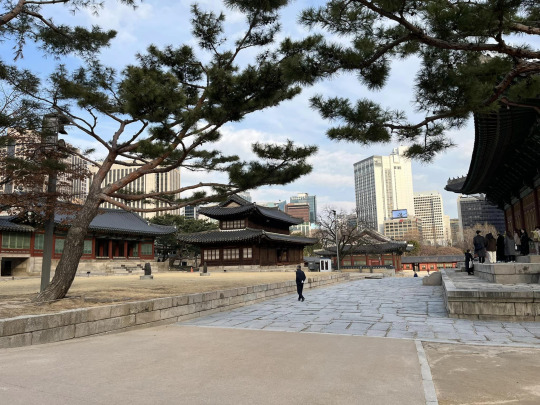
And while the visit to the DMZ was an eye-opening experience (my grandparents on my father's side actually met during the conflict although neither were on the frontlines), I couldn't help but feel I had missed an opportunity to chat with a few fellow Australians on the trip.
Still, I want to end his blog post by thanking Seoul City Tour, and Yeoni in particular, for taking us around the DMZ and safely getting us back to Seoul in one piece! You may have thought I was bleachpanda and the start but you certainly warmed to Kyndaris as the day went by. Even acknowledged us when we nearly missed the coach at the Peace Park because I had to search for a bin in order to throw the remains of my soy fried chicken away because the bus driver wouldn't let bleachpanda and I bring it along.
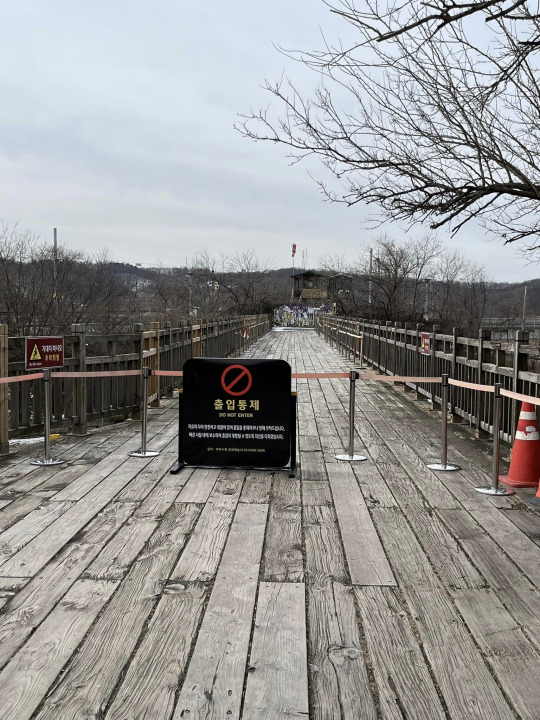


#personal blog#travel blog#travelling#seoul#dmz#38th parallel#peering into north korea#deoksugung palace#seoul city bus#video game and poem reference
3 notes
·
View notes
Text

© Paolo Dala
Before The Great White Throne
Morgan Wilson had his four-foot (4-ft) putt lined up perfectly. He was about to tap the ball in the hole when he suddenly clutched his chest and collapsed onto the green.
The panicked voices of his buddies faded away as he felt himself traveling through a dark tunnel and then all at once he was in a mode of existence unlike anything he'd experienced on Earth. Unknown to him, he was in Hades, the abode of the wicked, as they await the day of judgment.
There were many other souls around him. More continue to flock in. Their bodies were like his own, wispy and insubstantial, but with all sense intact. At one end of the room, guarding a massive door stood a man-like figure who was so bright that Morgan could hardly look at him.
One by one, waiting souls were called to the door. When Morgan's turn came, he passed through the door and what he saw took his breath away. His eyes strained to take in the other worldly beauty and majesty.
Directly before him towered a Great White Throne. He looked into the face of the one sitting on it and he was undone. The face radiated pure love and infinite sorrow. In that instant, Morgan realized that this face, this being had somehow always been the reality behind every longing that he had ever had. The Man's hands were scarred as if they had been impaled by some sharp instrument. With a stab of fear, Morgan realized that he was in the presence of the Lord Jesus Christ.
Panic welled up in him as he reflected on his Earthly Life which had not always been what it ought to have been. In a rich, pure voice, Christ called Morgan by name. Morgan was drawn forward like a magnet. For the first he noticed, there were some books stacked on a table beside the throne.
Jesus Christ picked up the first one and Morgan got a glimpse of its title: 'The Book of the Law'. Christ opened the book and placed it on his lap.
"Morgan Wilson", he said, "what do you have to say regarding your life on Earth?"
In spite of his trembling, Morgan found his voice:
"Well, I tried my best to obey your laws and when I think of other people I know, I think I did better than most."
"Very well since you expect to be saved by your good works, let's consider what that requires."
Looking at the book, Christ reviewed aloud each point of the law and then looked at Morgan,
"Have you done all of these things?"
"Well, not perfectly, of course, but I think the good outweighs the bad."
"Well I'm afraid that's not good enough", Christ said. "If you base your salvation on the law, you must keep all the law, obeying every single point without fail."
"But if that's the case, who can be be saved", Morgan said. "The Bible says all have sinned and have fallen short."
"You were exactly right", said the Lord Jesus. "That's why I died for you. I never sinned. I took the penalty for your sin in order to free you from it."
He closed 'The Book of the Law' and picked up the next volume: 'Morgan Wilson's Book of Works'.
As he opened it, Morgan's fear began to ease. I mean, he had done many good works and he felt sure the Lord would really be impressed!
"[It] says here that you gave $1,000.00 to your church's New Building Fund."
"That's right", Morgan said, "and I set an example by being the first one to do it."
[Morgan continued:]
"I also do many other good things! I was a deacon in my church. I occasionally taught Sunday School. I never missed a church service, even on on Wednesday and I seldom fell asleep during the sermons."
[Jesus replied:]
"Yes, all these things are recorded here, but it is also recorded that you made sure all of these things were visible to other people. You did it for them."
Suddenly, Morgan felt exposed. He could muster no response. Christ closed the book and reached for the next one, 'Morgan Wilson's Book of Secrets'.
"You got a lot of entries in this book, Morgan", Christ said. "Let's look at some of the things you did in secret."
[Christ continued:]
"It says here that many of your customers paid you in cash and you reported none of those payments to the IRS. You also reported business losses you did not incur and inflated the amount of your charitable gifts. You cheated on your income tax and according to this records, you did it every single year... Says here you visited the internet porn sites late at night. And to top it off, these records indicate that you had a long, running affair with a woman in your church. None of these deeds were ever found out and since they never damaged your reputation, you never repented of them. The bottomline is that you did your good works in public and your evil ones in secret. You should have done the opposite. You should have done your good works in secret so that your reward would have been my riches instead of the praise of people and you should have aired your evil deeds in confession and repentance."
Morgan looked down in shame as Christ closed 'Morgan Wilson's Book of Secrets' and reached for the next one, 'Morgan Wilson's Book of Words'.
"I see two categories of words in this book", He said, "those reflected the attitude of your heart and those that hid the attitude of your heart..."
You hardly ever read your 'Bible'. Yet, you quoted from a list of Scriptures you memorized to impress other church members. You spoke to your church's youth group about keeping their speech clean, while you knew in your heart that your own jokes with your golfing buddies were not even fit for the gutter."
Christ shook his head and He closed the book.
"I see that you have one more book to open", Morgan said, "is there any chance it might somehow override all that's been written in the other books?"
Jesus picked up the heavy volume..."This is 'The Book of Life'. The name of every person ever born has been entered into this book. Tragically, however, many of the names no longer appear. They have been blotted out."
"Please", Morgan said, "please open that book and see if by some chance my name is still there!"
Jesus turned slowly through the pages, scanning each one, and finally, He closed the volume and looked at Morgan... "I'm sorry to say you that your name is not here. You do not belong to me and I must banish you forever from my presence."
[Morgan replied:]
"But what about grace?! Can't you give me grace?!"
[Jesus:]
"Morgan, my grace was always available to you. All you ever had to do was place your trust in me and make me the Lord of your life. Had you done that, my grace would freely cover all of your sins and all of your failures, but you never did that. You never surrendered to me and allowed your heart. Therefore, you never knew me and now, I do not know you."
The angel led Morgan to another door, this one dark and ominous. On the far side of the great hall, there he was thrust into darkness. The door slammed behind him echoing in the empty blackness. Morgan couldn't see anything, no sun, no moon, no stars. Not a single ray of light. He groped about with his and tried to find footing for his feet, but there was nothing. Though he had now weight, he had the sensation of falling through the darkness... He heard nothing but the own sound of his weeping. He was isolated from all humanity and he would be so for all eternity.
Eons passed and the forgotten soul of Morgan Wilson still plunged downward into the vast black void. He had decayed into something less than human, becoming nothing than a perpetual hunger... For all of eternity he would writhe in despair. His torment never-ceasing. He would never be reclaimed. He would never again have hope.
NO ONE WHO STANDS BEFORE THE WHITE THRONE JUDGEMENT WILL COME OUT INNOCENT. ALL WILL BE JUDGED GUILTY BECAUSE THEY REFUSED TO RECEIVE THE OPPORTUNITY OF SALVATION THROUGH JESUS CHRIST.
The account of The Great White Throne Judgment in 'Revelation 20' in my estimation is the most sobering passage in all of the Bible. It tells of The Final Judgment of the inhabitants of planet Earth, the last sentence of the passage is chilling, 'Revelation 20:15'...
"ANYONE NOT FOUND WRITTEN IN 'THE BOOK OF LIFE' IS CAST INTO THE LAKE OF FIRE."
David Jeremiah The Judge
#David Jeremiah#The Judge#Theology#Turning Point#Still Life#Court#Judgment#The Great White Throne#Revelation#Palace#Deoksugung Palace#Seoul#South Korea
0 notes
Text
DEOKSUGUNG SEOKJ0JEON HALL (PART 1)
덕수궁 석조전 (제 1부)


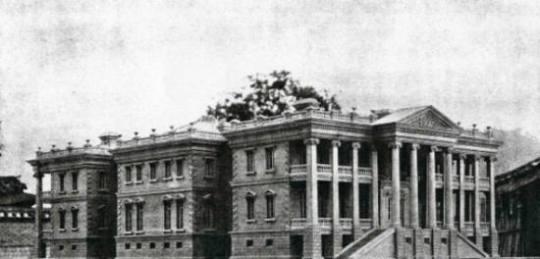

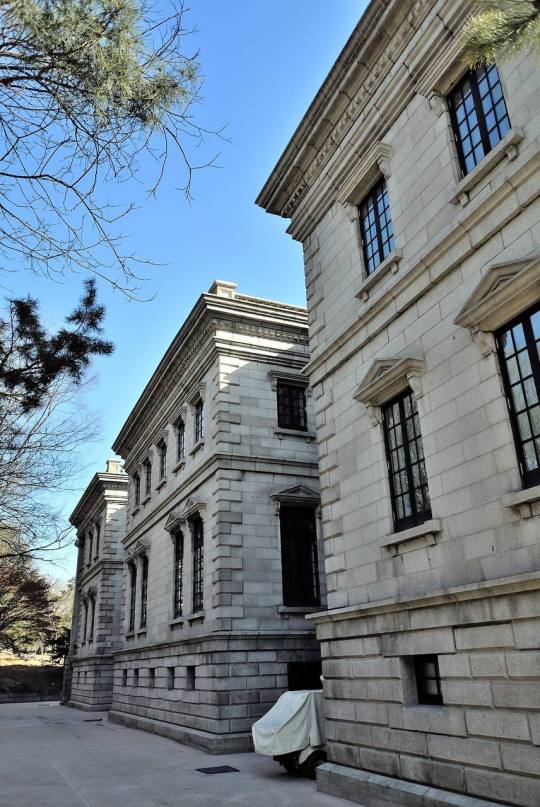
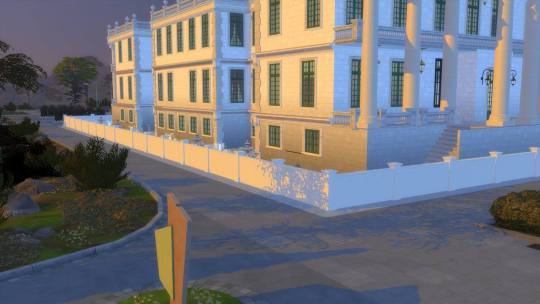
After 15 months of gradual but constant commitment, I finally completed this project!
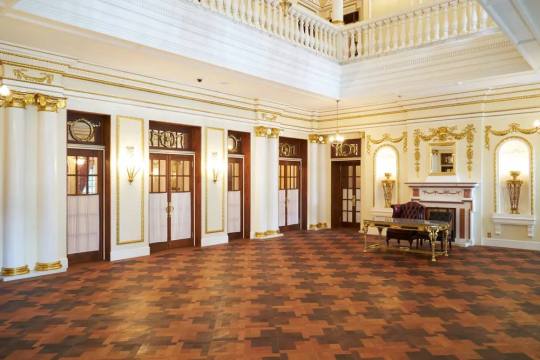

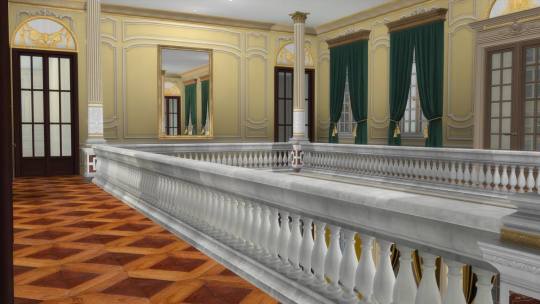
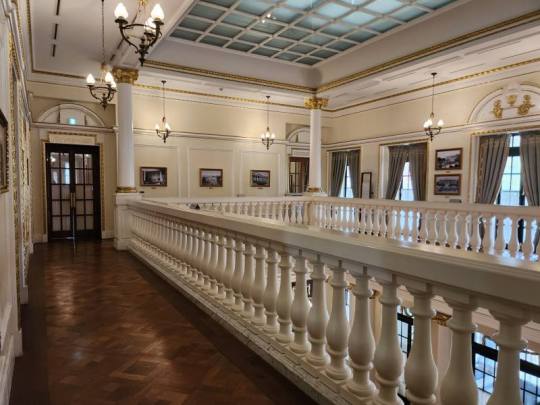
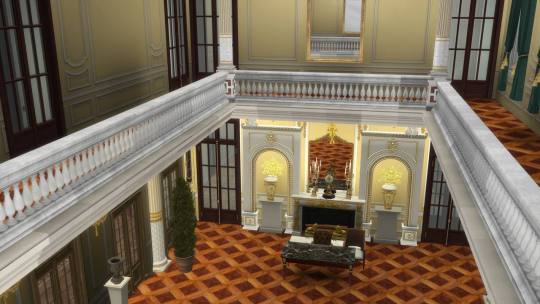
Central Hall (중앙홀)
The main hall is a two-story structure space. It is the first space to enter when viewing.
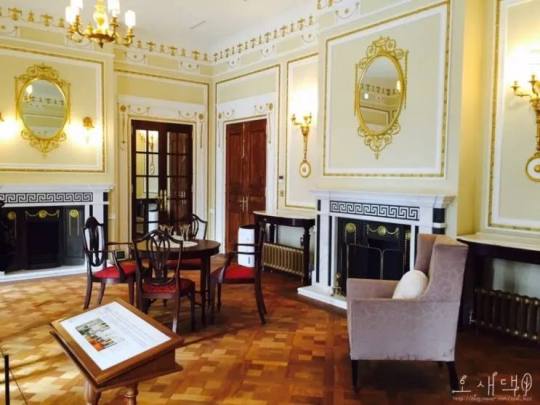
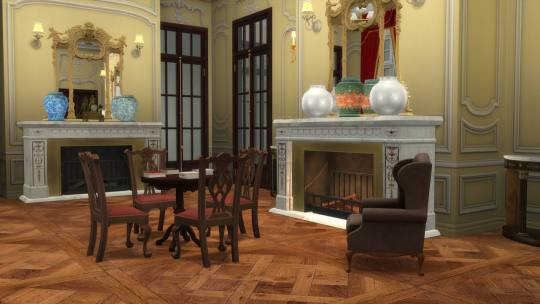

VIP Waiting Room (귀빈 대기실)
This is the right-side hall. It's the room visitors move into after touring the central hall. This room, where guests waited to be announced to the emperor, has the same interior design as the central hall, except it lacks decorative pillars. The left door is a fake designed to strictly adhere to the English neoclassical interior style characterized by strict symmetry and opens to reveal only a blank wall.
Visitors typically waited for the emperor's audience while enjoying biscuits, snacks, champagne, and so on, served by the royal household.
The waiting room has a console table, a regular table, a round table, four chairs, an armchair, and a display cabinet. Among these, the armchair and display cabinet are original pieces, while the rest are replicas recreated based on a catalogue commissioned from Maple Furniture Company at the time of construction.

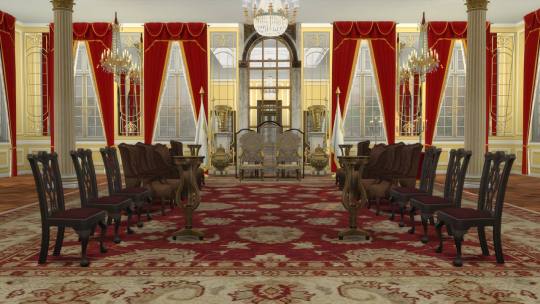
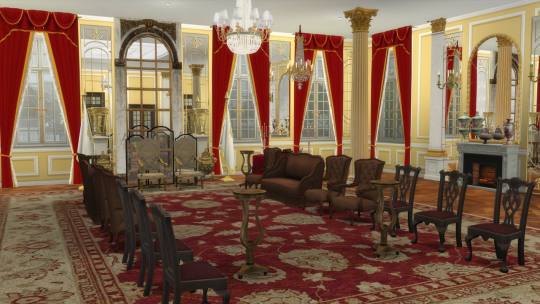
Reception Room (접견실)
This is a room located above the central hall, and it is the largest room on the first floor. It is where the emperor held audiences.
Audiences involved the emperor being approached, bowing three times in greeting, and then departing backwards, which was quite bewildering and challenging for foreign envoys.
The most expensive item in the reception room was imported European wall mirrors. The Palace of Versailles in France had a Hall of Mirrors at its centre, as mirrors were incredibly expensive and extravagant luxury items of the time. Decorating the palace, the centre of both the court and France, with mirrors was a sophisticated political manoeuvre to diminish the pride of foreign envoys and secure France's diplomatic dominance by showcasing a grand gallery of mirrors. Mirrors were costly because only skilled artisans from Venice could produce them, and there are stories of considerable efforts made by France to acquire this technology. The mirrors in the Seokjojeon Hall reception room were imported directly from Europe, cut into decorative shapes, and transported very carefully over an extended period.
The ceiling in this space is lower compared to others, likely due to its settling during the Korean War.


The Small Dining Room (소식당)
The Small Dining Room is located to the left of the reception room. While it appears to have been a gathering place for the royal family for meals, it was actually a room where a few select guests had simple meals. Compared to the main dining hall, the dining table here is smaller, accommodating up to about 5 people at most. In one corner of the room, there is a cabinet for storing spoons, knives, and forks. The ivory tableware displayed there was reportedly acquired through an auction in England during the restoration period.
This room is unique among the others in its interior finish, featuring panelling made of English oak with a lacquered appearance.
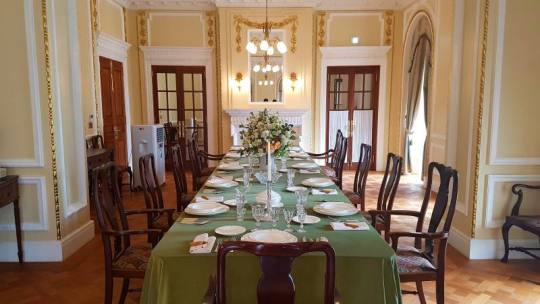
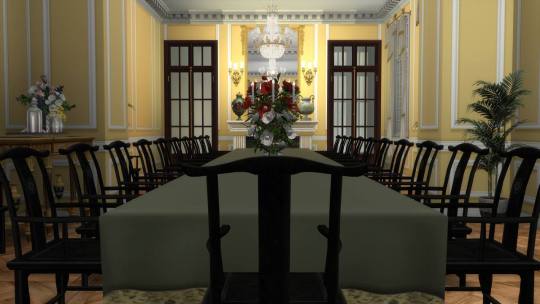
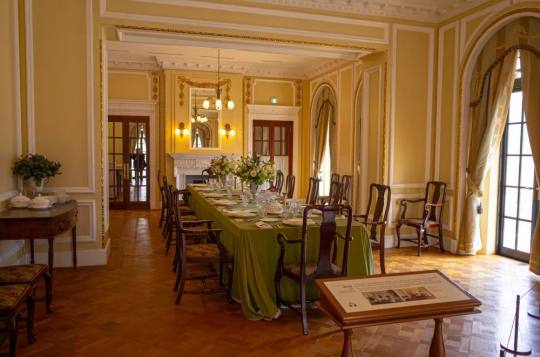
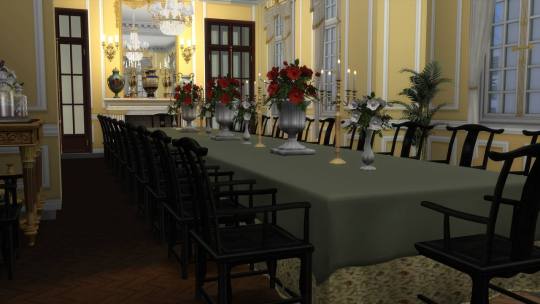
The Grand Dining Room (대식당)
The Grand Dining Room is a dazzling space that captures the attention of visitors with its crystal chandelier, luxurious tablecloths, and tableware. Located to the left of the central hall, it was a space where Western-style banquets were served to participants after formal events. The room is adorned with a long dining table and multiple chairs.
#the sims 4#ts4#simblr#sims 4#sims 4 custom content#sims 4 screenshots#the sims 4 cc#the sims cc#sims 4 palace#palace#architecture#building#sims 4 emperor#koreanempire#south korea#korean#joseon era#seokjojeon#deoksugung#sims#sims 4 gameplay#sims 4 cc
15 notes
·
View notes
Text
📍 Deoksugung Palace 덕수궁
#Deoksugung#Palace#덕수궁#cute#cafe#fypシ#서울#travel#korea#koreatravel#Seoul#attraction#mustsee#nature#aesthetics#street#fyp#travelguide#KoreaTrip#minivlog#KoreaVlog
0 notes
Text
Seoul: The Deoksugung Palace
Midst in the city of Seoul is the Deoksugung Palace. I was lucky to be there early morning with almost no other tourists. Under the cold blue sky lies this gem with its beautifully restored buildings surrounded from the big city. This palace was in use until the begin of 20th century and some building shows a mix of western and traditional architectures. Also were some rooms fitted with…
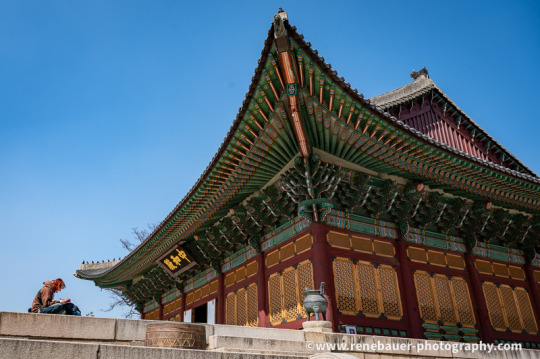
View On WordPress
#Asia#deoksugung#guard#history#palace#people#renebauerphotography#reportage#seoul#sightseeing#SouthKorea#Travel
1 note
·
View note
Text
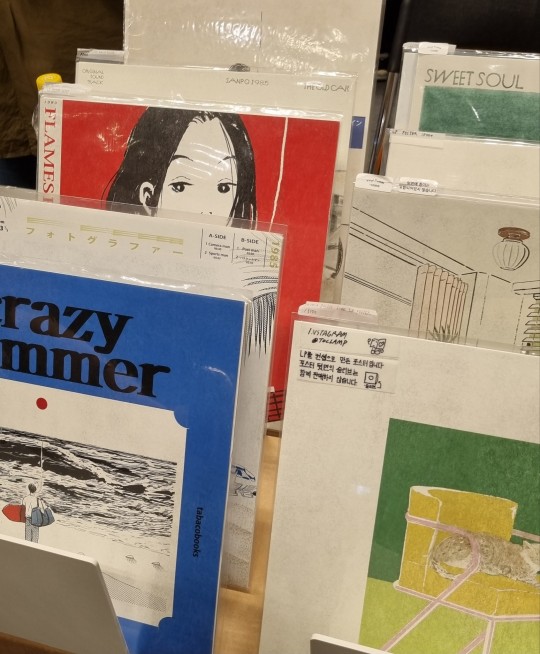
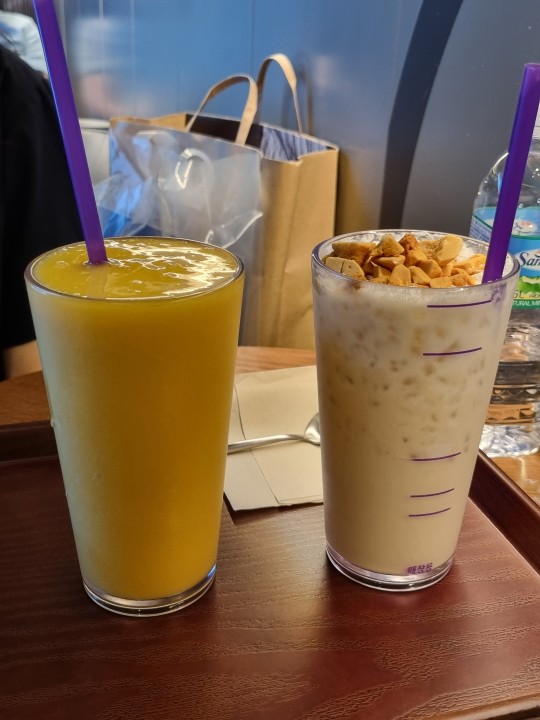
12.07.2024 [😚]
⏳️: 석조전 해설 투어 가기/ The day I visited Deoksugung Palace
#diary#online diary#student#study aesthetic#study blog#study motivation#study tips#studyblr#online#journal#academia aesthetic#classic academia#academy#dark academia#academia style#dark acadamia#dark acadamia aesthetic#lifestyle blog#daily blog#blog post#blogger#blog#study time#studies#study hard#studying#light acadamia aesthetic#light indie#light#light academia
72 notes
·
View notes
Text
youtube
FILM VLOG 📷 Heading to Deoksugung with a film camera (feat. a palace that lived in a past life🫅)
18 notes
·
View notes
Text
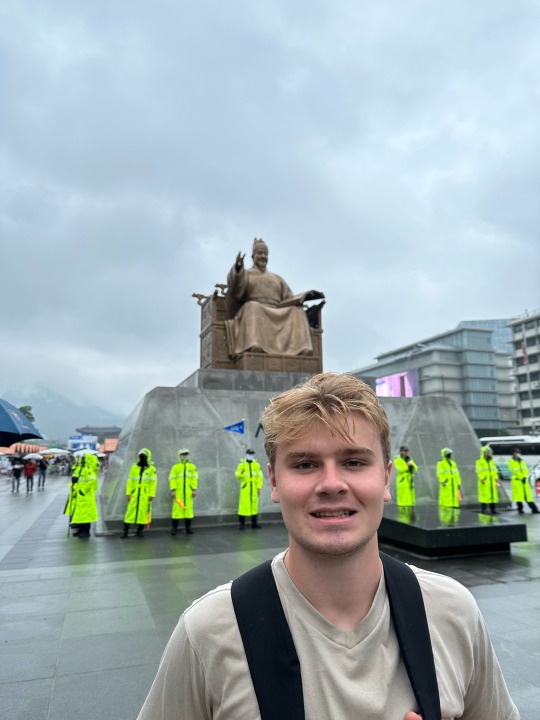
Tag 40. 12.08.2023
Nokdujeon, Gimbap und Fishcakes. Heute war ein ereignisvoller Tag angesagt. Nachdem wir Brot beim Bäcker holten und einen Kaffee tranken schlenderten wir durch die Einkaufsstraßen in Myeongdong. Wir gingen in die Nike-Läden und liefen ins Apple Store, wo wir uns den Angestellten austauschten. Daraufhin ging’s zum Deoksugang Palast, wo wir die verschiedenen kaiserlichen Häuser beäugten und die gepflegten Gärten bewunderten. Draußen warteten wir vergeblich auf den Wechsel der Garde, anscheinend fand die tägliche Zeremonie heute später statt.
Anschließend liefen wir entlang der Sejong-daero-Straße Richtung Gyeongbokgung Palast. Auf dem Weg fanden im niesenden Regen etliche Demonstrationen statt, irgendwie alle mit dem Koreakrieg oder Japan verbunden. Auch hielten wir an einem Denkmal des 2022 Itaewon Disasters, wo 153 Menschen bei einer Panikmache in einem engen Seouler Gässchen ihr Leben verloren. Frustrierend.
Daraufhin entdeckten wir das Bukchon Hanok Viertel, wo niedliche Gaststätten und Tante Emma Läden sich auf einem Hang abwechselten. Hier aßen wir in einem Imbiss Frittiertes, scharfe Reisrollen und Fishcake-Spieße. Wir schlenderten dann entlang der Seosulla-Gil (neben des Jongmyo-Schreins), wo sich Studenten in etlichen Cafés auffanden und an einem regnerischen Samstag trafen, Richtung Gwangjang Markt angesagt. Hier probierten wir Gimbap (koreanisches Sushi), Nokdujeon (bohnenbasierte Pfannkuchen) und koreanisches Tartar aus. Köstlich. Der Markt war vollgepackt, v.a. mit Scouts (Pfadfinder) verschiedener Länder, die sich auf einem internationalen Scout-Gipfel in Seoul befanden. Irgendwas lief vorherige Woche mit der Organisation schief, viele Scouts sind also schon wieder nach Hause geflogen, viele sind noch da, alles sehr merkwürdig. Der Gwangjang Markt war trotzdem bereichernd und Schauspiel einer unerwartet leckeren Mahlzeit.
Wir liefen schließlich neben dem tiefgelegten Flusspfad Richtung Hotel. In Myeongdong schauten wir allerdings noch in ein paar Geschäfte rein bevor wir im 7-11 Snacks und Frühstück holten. Morgen gehts nach Bundang und auf den Han-Fluss! Bis dann!
Day 40. August 12, 2023
Nokdujeon, Gimbap, and Fishcakes. Today was expected to be an eventful day. After getting bread from the bakery and having a coffee, we strolled through the shopping streets in Myeongdong. We went into the Nike stores and walked into the Apple Store, where we interacted with the employees. After that, we headed to Deoksugung Palace, where we observed the different imperial houses and admired the well-maintained gardens. Outside, we waited in vain for the changing of the guard; apparently, the daily ceremony was scheduled for later today.
Subsequently, we walked along Sejong-daero Street towards Gyeongbokgung Palace. Along the way, numerous demonstrations took place in the drizzling rain, all somehow connected to the Korean War or Japan. We also stopped at a memorial for the 2022 Itaewon Disaster, where 153 people lost their lives during a panic in a narrow Seoul alley. Frustrating.
Then, we discovered the Bukchon Hanok Village, where charming eateries and small convenience stores alternated on a slope. Here, at a snack stand, we had fried food, spicy rice rolls, and fishcake skewers. We then strolled along Seosulla-Gil (next to Jongmyo Shrine), where students gathered in various cafes on a rainy Saturday, heading towards Gwangjang Market. Here, we tried Gimbap (Korean sushi), Nokdujeon (bean-based pancakes), and Korean tartar. Delicious. The market was packed, especially with scouts from different countries who were attending an international scout jamboree in Seoul. Something went wrong with the organization last week, so many scouts have already flown back home, and many are still there – quite strange. Nevertheless, Gwangjang Market was enriching and a stage for an unexpectedly delicious meal.
Finally, we walked along the low-lying river path towards the hotel. In Myeongdong, we stopped by a few shops before getting snacks and breakfast at 7-11. Tomorrow, we're off to Bundang and the Han River! Until then!
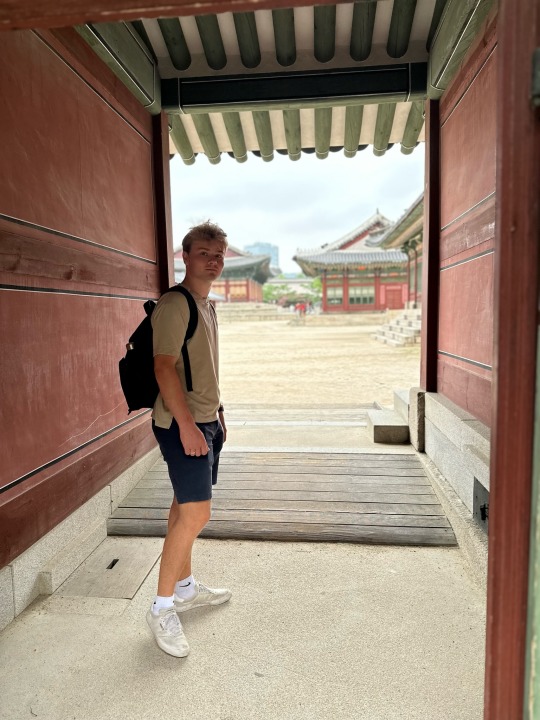

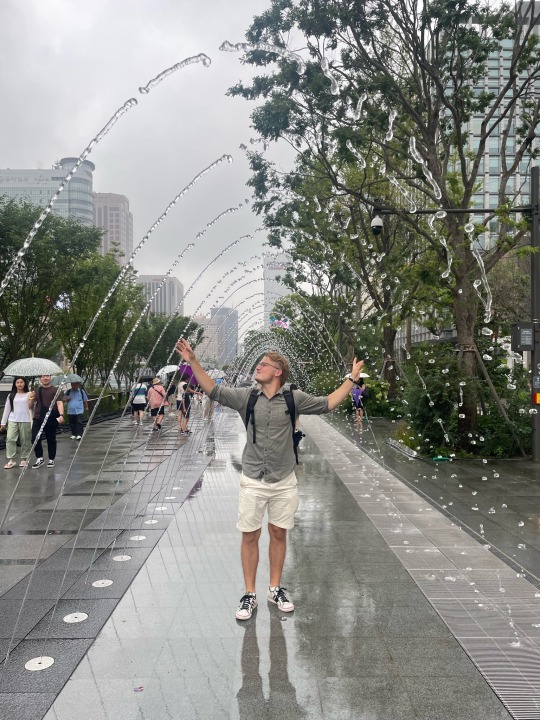
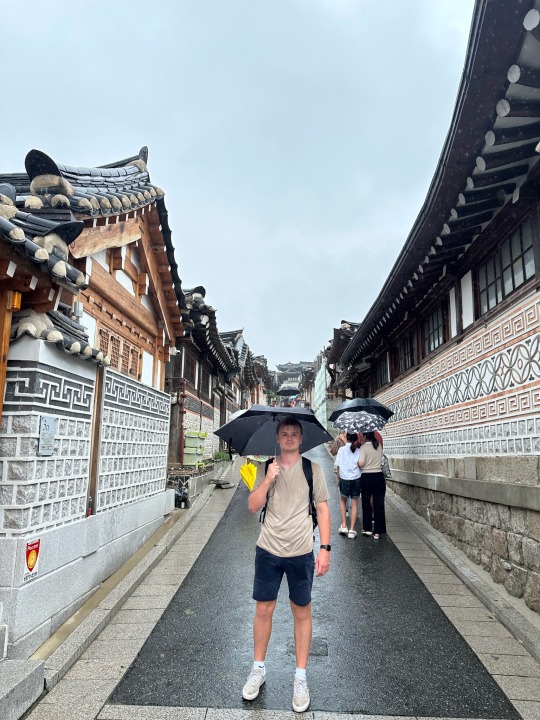
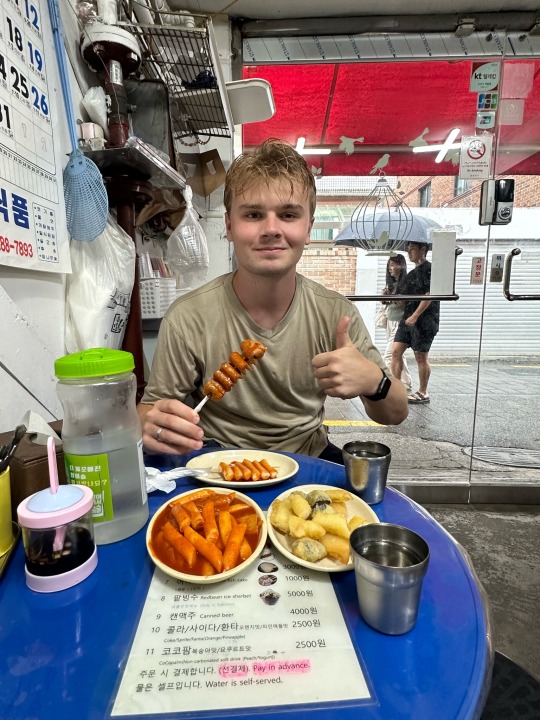
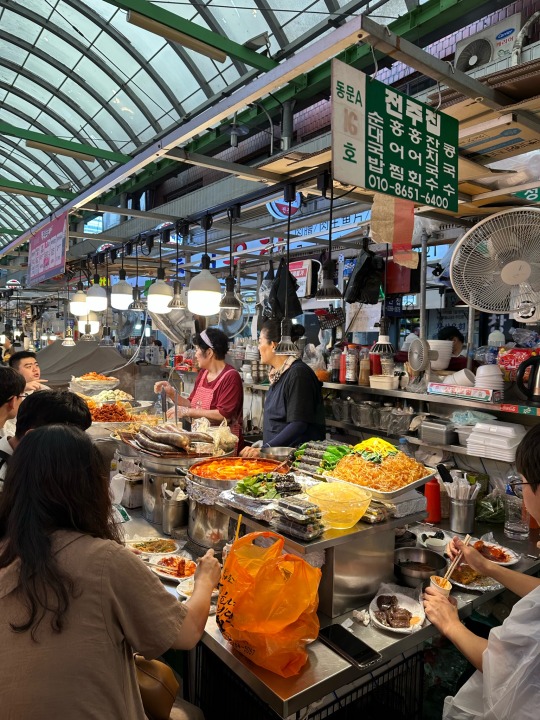
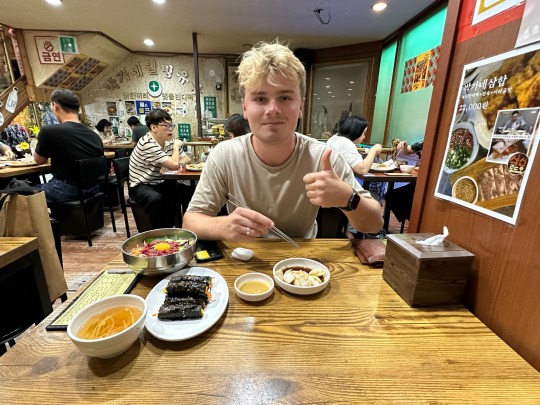
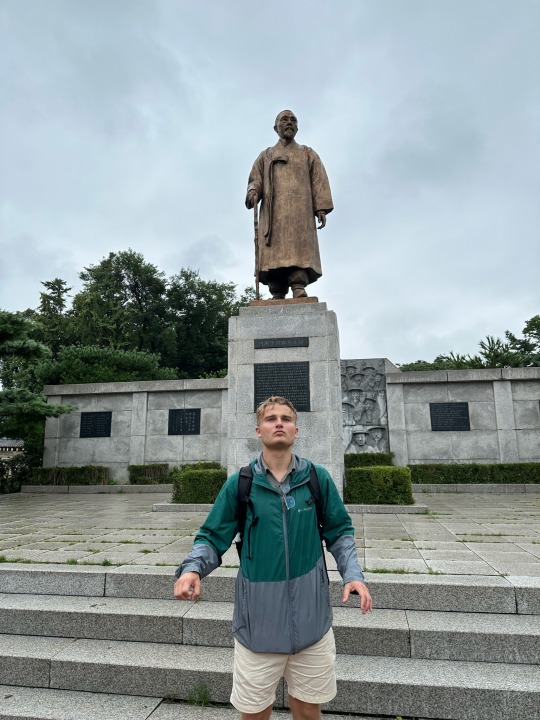
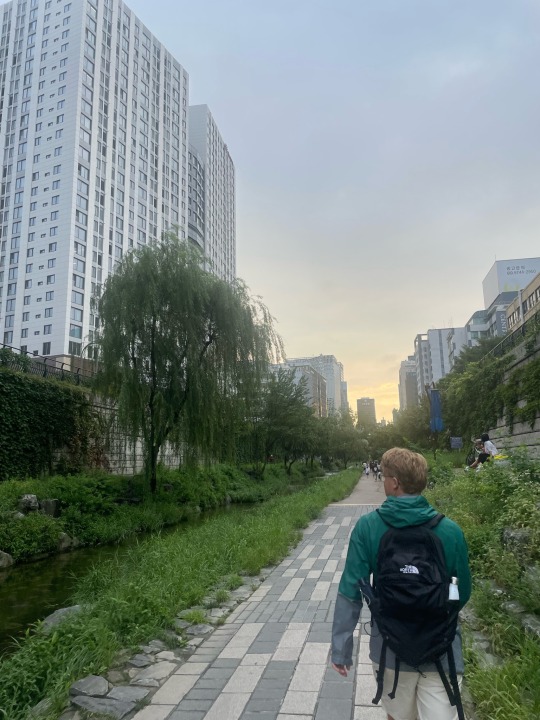
3 notes
·
View notes
Text
youtube
Lee Suhyun at Seokjojeon Hall - Deoksugung Palace for Disney Korea's "Mickey & Friends: Seoul Tour"
1 note
·
View note
Text





An evening visit to Deoksugung Palace in Seoul.
3 notes
·
View notes
Text
Explore the Majestic Palaces of Seoul: A Glimpse into Korea’s Royal Legacy

Seoul, the vibrant capital of South Korea, stands as a testament to a harmonious blend of modernity and tradition. Among its many cultural treasures, the five grand royal palaces offer a captivating journey into the rich history of the Joseon Dynasty. These architectural masterpieces not only embody Korea’s royal heritage but also provide visitors with a serene escape from the city’s bustling energy. Here, we delve into the splendor of these palaces and why they’re an essential part of any itinerary, especially for those exploring South Korea holiday packages from Dubai.
1. Gyeongbokgung: The Grand Palace
Gyeongbokgung, or the "Palace of Shining Happiness," is the largest and most iconic of Seoul’s royal palaces. Built in 1395, it served as the main royal residence during the Joseon Dynasty. Visitors can marvel at its grand throne halls, intricate architecture, and the scenic Gyeonghoeru Pavilion. Passing through the majestic Gwanghwamun Gate sets the tone for an unforgettable historical exploration.
Don’t miss the daily changing of the guard ceremony, a vivid display of traditional Korean culture and royal protocol.
2. Changdeokgung: A UNESCO World Heritage Site
Recognized as a UNESCO World Heritage Site, Changdeokgung Palace is celebrated for its seamless integration with nature. The palace’s Secret Garden (Huwon) is a highlight, offering picturesque landscapes, lotus ponds, and pavilions that exude tranquility. The palace’s architecture and natural surroundings reflect the Confucian philosophy that shaped Korea’s cultural and political landscapes.
3. Deoksugung: A Blend of East and West
Deoksugung Palace is the smallest of the five palaces but is perhaps the most unique. Its striking combination of traditional Korean architecture and Western-style buildings makes it a fascinating site. The palace grounds also host the National Museum of Modern and Contemporary Art, providing an additional layer of cultural insight.
Evening visits to Deoksugung are magical, as the palace is beautifully illuminated, offering a romantic ambiance for visitors.
4. Gyeonghuigung: The West Palace
Known as the "Palace of Serene Harmony," Gyeonghuigung served as a secondary palace for the royal family. Though simpler in design compared to its counterparts, its peaceful gardens and historical significance make it a hidden gem for those seeking a quieter, more contemplative experience.
5. Changgyeonggung: A Palace of Legacy
Originally built for Crown Prince Sado, Changgyeonggung Palace boasts architectural brilliance and a rich history. The palace is well-preserved, allowing visitors to step back in time and envision life during the Joseon Dynasty. The surrounding grounds include a greenhouse and arboretum, adding to its charm.
Why Visit Seoul’s Palaces?
Seoul’s palaces are more than just historical landmarks; they are windows into Korea’s royal past and cultural identity. Each palace offers unique insights into the artistry, philosophy, and lifestyle of the Joseon Dynasty. Whether you’re strolling through tranquil gardens or admiring intricate architectural details, these palaces promise an enriching experience.
For travelers seeking comprehensive South Korea holiday packages, including visits to these royal sites ensures a deeper connection to the country’s heritage. If you’re embarking on South Korea holiday packages from Dubai, make sure to include these majestic palaces in your itinerary for an unforgettable journey.
#SouthKoreaTravel#SeoulPalaces#KoreanHistory#TravelToSeoul#JoseonDynasty#CulturalHeritage#ExploreKorea#SouthKoreaHolidayPackages#TraditionalArchitecture#VisitSeoul
0 notes
Text
Ain't No Mountain High Enough
Our first proper day in Seoul had us running through the city using my highly advanced map-reading skills because Google Maps could not show even simple routes in and around the city except via public transport. This was due to the censorship laws of South Korea preventing the storage of map data on foreign server devices. As a consequence, Google cannot legally provide any real time navigation. Or so Google and Reddit tell me. Instead, locals rely on Naver and Kakao, but which do not always have English translations and thus tourists such as bleachpanda and myself are left fending for ourselves.
Still, after enjoying a ham and cheese 'Dagel' for breakfast at a local cafe, bleachpanda and I set out to Namsam Seoul Tower (or N Seoul Tower for short). Along the way, we stopped at the Namdaemun Market. There, we inspected the stalls to see what was on offer. Although we were both tempted to purchase souvenirs at this very first stop on our journey, we both resisted the urge.
We had, after all, not even properly seen the city!

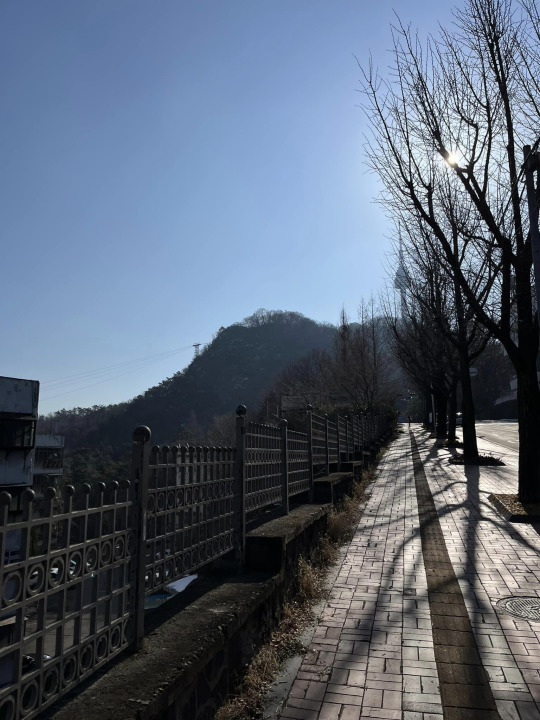
Instead, bleachpanda and I purchased some egg tarts and a warm drink to drive away the wintry chill. While bleachpanda guzzled down her mocha, I was left disappointed by my 'choco latte,' which turned out to essentially be chocolate milk.
From Namdaemun Markets, we hiked towards Namsan Mountain, visiting a local 7-Eleven along the way to see if they shared any similarities to their counterparts in Japan or Australia (spoiler alert: they shared much more with their Asian cousins in Taiwan and Japan than those found out in the West).
Once at the start of the hiking trail up to Namsan, bleachpanda blanched at the prospect of climbing up to the tower. But with some gentle coaxing from me, she acquiesced. And so, we clambered up the mountain.
Bleachpanda, being the less fit of the two of us, required numerous stops to catch her breath. But these rests were also opportunities for us to take pictures of the scenery - capturing the early moments of spring peaking through as the snow began to melt.
By the way, did I mention there were love locks all around N Seoul Tower? Because that was a thing. As well as at the base of the mountain having a statue dedicated to the Comfort Women from the Second World War.
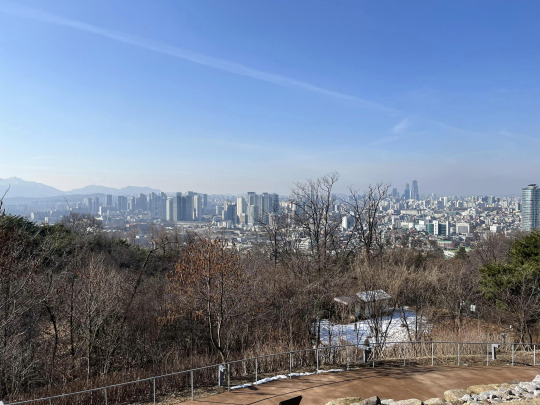
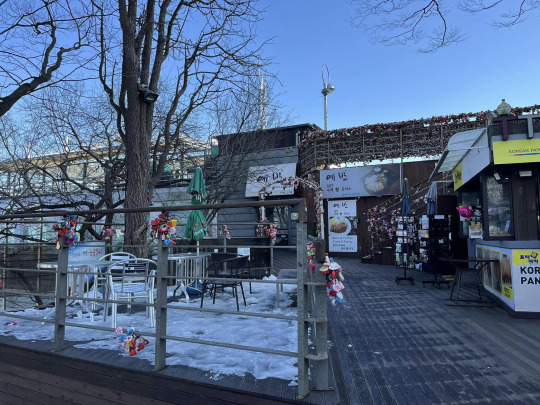
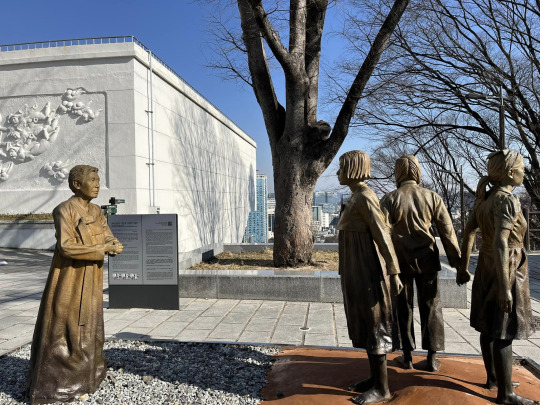

Still, it was aggravating to wait for her but it was the cross I had to bear as her travelling companion. Especially as we were nearing the tower and she vanished for nigh on eighty-four years because she ducked into a store to buy a fridge magnet.
At the tower, I purchased our entry tickets up and away we soared to the observation deck with a group of American tourists. Once at the observation deck, the entirety of Seoul was spread out before us. I used this chance to take copious amounts of pictures from this bird's eye view of the city:



Bleachpanda and I even bought a few souvenirs, including postcards. While I sent mine to a good friend (here known as redoubt on the internet), as he has a penchant of posting postcards to me when travelling overseas, bleachpanda sent one to her sister and another to her future self.
Once we had drunk our fill at the tower, we took the cable car back down to civilisation (bleachpanda's request) before heading to Deoksugung Palace. As I navigated our party towards our destination we refuelled at a Dunkin' Donuts before continuing onward.
Unfortunately, once we arrived at Deoksugung Palace, it was closed (this was due to the fact this palace is closed on Mondays. Why? I'm not sure. We would revisit it later). Disappointed, bleachpanda and I trekked instead to Gyeongbokgung Palace where we managed to catch a changing of the royal guard. During the performance, an explanation was provided regarding the process and of the outfits worn by the performers, which were based on 15th century Joseon dynasty clothing.
Fun fact, Gyeongbokgung was the main royal palace of the Joseon palace and was built in 1395. Additionally, everywhere we looked, there were people dressed in hanboks because they allowed free entry!
Alas, bleachpanda and I were dressed in our thick entry gear. And so, we had to buy tickets to visit Gyeongbokgung Palace. I also grabbed an audio gudie to provide some commentary of the historic site we were visiting, although I had to trade in my driver licence.




As we made our way through the Palace, I learned how the Palace served as the heart of the Joseon dynasty before it was razed to the ground when Japan invaded Korea back in 1592. This was later rebuilt in 1867. Within were several precincts and the living quarters for concubines and the royal family. Of interest to me was how there were separate palaces for the King and the Queen.
I also learned how during the Japanese occupation in the early 20th century, Gyeongbokgung was used for their own headquarters, with the Government-General Building being built after the Palace was levelled. After the conclusion of the Second World War, however, much of Gyeongbokgung has been restored.
After we had wandered through to all the major sites, bleachpanda and I exited out near the National Folk Museum of Korea. Eager to have my driver licence returned, we headed back to the entrance and exchanged the audio guide for my Australian identity document.
From the palace, we then headed to Bukchon Hanok village and finally nabbed a late lunch of pork cutlet - elsewise I might have keeled over. After we were both full, we took a gander around Bukchon, stopping by Bukchon Yukgyeong to snap an iconic view of the city of the buildings there and the city of Seoul splayed out before us.
Once we had snagged the picture, bleachpanda and I headed back to our hotel after a long day out in the city of Seoul. We stopped briefly at Jogyesa Buddhist temple before purchasing a few souvenirs and snacks.
So ended our first proper day in Seoul! Join me for the next few weeks as I regale you, dear reader, of our further adventures! For tomorrow is when we head into the DMZ (the last letter pronounced as Zed for all you Americans out there).
Looking back on our journey though, I'm a little sad I couldn't snag myself a hot CEO boyfriend after he hit me with his car. Still, there's always next time!
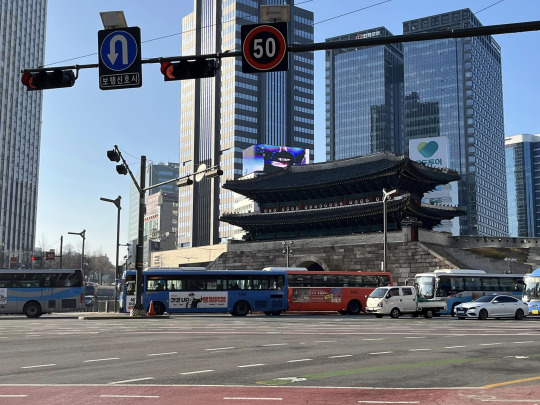
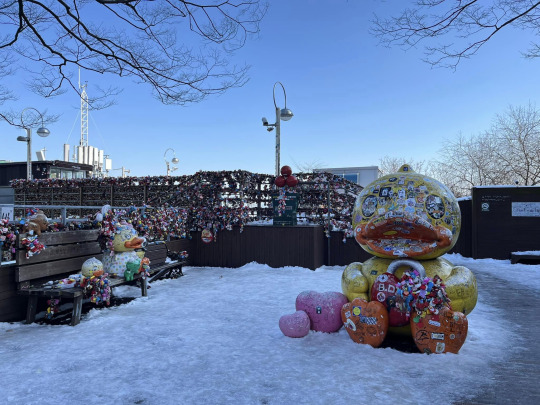
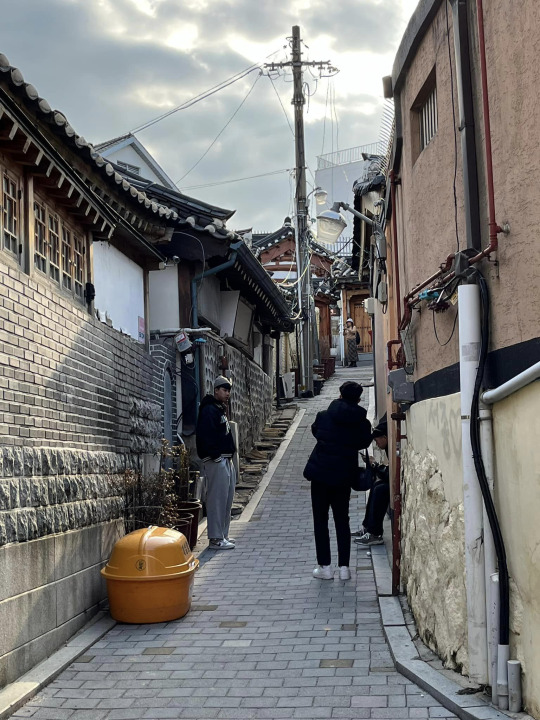

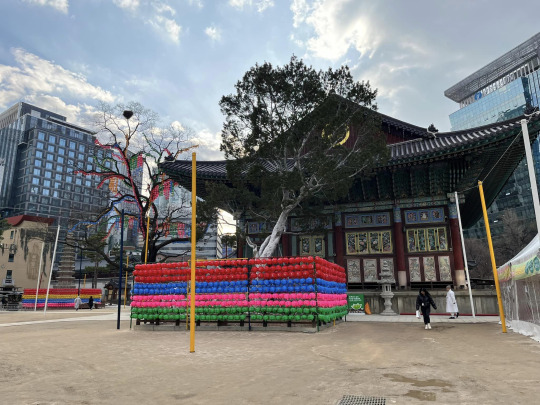
#personal blog#travelling#travel blog#seoul#south korea#n seoul tower#gyeongbokgung palace#bukchon hanok village#jogyesa temple
3 notes
·
View notes
Text










덕수궁
Deoksugung Palace
Imperial Palace of the Daehan Empire
1 note
·
View note
Text
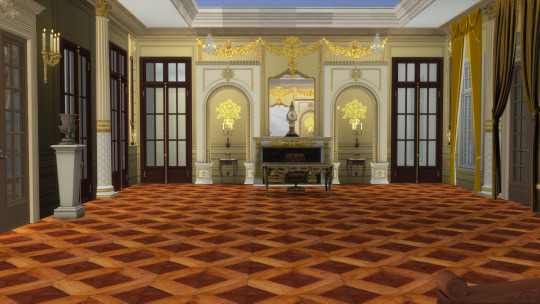

WIP SEOKJOJEON BUILDING PROGRESS


To date, I have finished constructing the Central Hall (중앙홀) and the Audience Hall (접견실). It is not 100% accurate due to some limitations and a lack of mods containing the details of the actual building, but I have to use some creative liberty to overcome the shortcomings.
#the sims 4#sims royalty#ts4#ts4 build#simblr#sims palace#sims 4#sims#sims 4 royal cc#sims 4 royal simblr#deoksugung#seokjojeon#the sims cc#sims 4 cc#sims 4 screenshots
11 notes
·
View notes